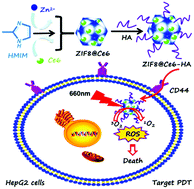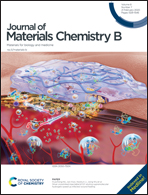A natural polysaccharide mediated MOF-based Ce6 delivery system with improved biological properties for photodynamic therapy†
Abstract
Chlorin e6 (Ce6) is a second generation photosensitizer for photodynamic therapy (PDT). However, free Ce6 still has some defects leading to reduced clinical efficacy, such as easy agglomeration in a physiological environment and poor accumulation in tumor tissue. In order to solve these problems, a hyaluronic acid (HA) modified zeolitic imidazolate framework-8 (ZIF-8) based Ce6 (ZIF-8@Ce6–HA) therapeutic agent is constructed for PDT by one-pot encapsulation and self-assembly. ZIF-8@Ce6–HA exhibits acceptable encapsulation efficiency, effective cell uptake and good biocompatibility. Moreover, the results of in vitro anticancer experiments demonstrated that the ZIF-8@Ce6–HA group exhibited greater cytotoxicity after irradiation than the free Ce6 group, which caused about 88.4% of HepG2 cells to die since ROS is produced by PDT. Additionally, the data of inductively coupled plasma mass spectrometry indicated that modification of HA increased the blood circulation time and reduced the systemic toxicity of ZIF-8@Ce6. In summary, this work created an interesting Ce6 therapeutic agent for PDT and provided the data for HA regarding the improvement in biocompatibility and biological half-life of metal organic frameworks.



 Please wait while we load your content...
Please wait while we load your content...